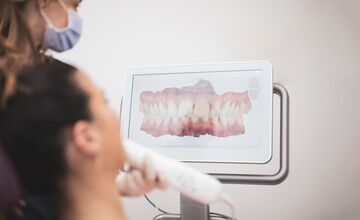
Dental Extractions In Warwick
Benefits of extractions
-
State of the art practice
-
Local independent practice
-
Highly experienced clinicians
-
Taking on new patients
Extracting a tooth may be required to help protect your oral health. The most common reasons for an extraction include overcrowding, decay, trauma and impacted wisdom teeth. If you’re in pain, an extraction will remove the source of your discomfort.
Tooth extractions are routine procedures that will deliver a quick and effective solution to your problem. We might recommend an extraction for a tooth that is severely weakened by trauma or decay. We might also recommend an extraction before orthodontics if you have overcrowding. And finally, extractions are also required when the wisdom teeth are impacted. This happens when there isn't enough room for the wisdom teeth to full emerge.
How do I know if my wisdom teeth are impacted?
If you have pain in your jaw or bleeding coming from the back of your gums, you might have an issue with your wisdom teeth. We will need to take X-rays to determine if your wisdom teeth are impacted.
Common signs of issues with your wisdom teeth include:
- Pain or swelling in the gum which indicates an infection
- Decay of the wisdom tooth and tooth next to it
- Gum disease
- Cysts
- Facial swelling
- Swollen or sore lymph nodes underneath the jaw
The dental extraction procedure
A dental extraction is one of the simplest dental procedures. You will be numbed throughout and shouldn't experience any pain or discomfort. To remove a tooth, we first need to manually loosen the roots by rocking it back and forth.
Once loosened, the tooth should come free from the jaw and will usually be removed in one piece. The tooth may occasionally break apart, and this will mean we need to expand the opening and remove the tooth roots with small tools. The entire treatment takes around 10-30 minutes from start to finish. Once completed, you will be free from the source of your pain.

Related treatments
Can I leave a gap in my smile?
After the extraction is completed, you will have a gap in your smile. For teeth at the back of your mouth, this may be less obvious than if the gap is near the front. You will need to decide if you would like to leave the gap in your smile or choose a restorative option.
Restorative options following an extraction could include a bridge, partial denture or dental implant. Replacing the missing tooth will help to protect surrounding teeth from shifting out of alignment. It will also help to preserve your bite and allow you to chew on both sides of your mouth. We can discuss restoration options with you following your extraction. There is no rush to choose, and we can wait for the extraction site to heal completely before taking after further steps.


Meet
our team
Get to know the team behind the treatments. We are proud to have built a team of experts and industry leaders. Meet the dental surgeons, dentists, dental nurses and support staff that will help support you on your journey to better oral health.
About the team
What to expect from your treatment journey
We want you to feel empowered and informed every step of the way. Understand what to expect during your treatment with this simple guide. Your exact treatment plan might change, but this will be explained during your consultation.

During your initial consultation, we will discuss your options, including extraction or other treatments. We try to keep extraction as a last resort, as preserving the natural tooth structure will always be the best choice.
We start by numbing the area and then loosening the tooth by rocking it back and forth in the socket. It should eventually come loose. Very decayed teeth can break apart during this stage, so we will need to remove the tooth roots using small tools.
You'll need to take special care of your teeth and gums following an extraction. Once healed, you can return to the practice to discuss restoration options, including dentures and bridges.

Frequently Asked Questions
It’s common to have lots of questions about your treatment. We’ve answered some of the most popular questions below.
A simple extraction can take as little as 5 minutes, with more complex cases taking up to 30 minutes. You will be numbed throughout the procedure and shouldn't feel any pain.
It usually takes around 7 to 21 days for the site to heal after an extraction. We recommend taking it easy for the rest of the day following your extraction. You will also need to avoid strenuous activity and heavy lifting in the days following the extraction. You'll need to brush carefully and avoid solid foods immediately after treatment.
A tooth extraction is quicker, but you will need to have follow up treatment to address the gap in your teeth. In general, we prefer to choose the treatment option that retains as much of the natural tooth as possible. Extraction should be used as a last resort for an infected tooth. The exception would be wisdom teeth, which may need to be extracted if they are impacted.



